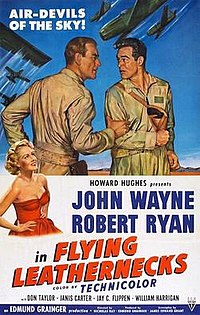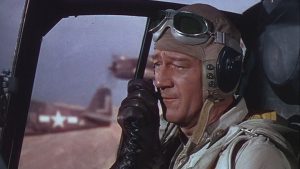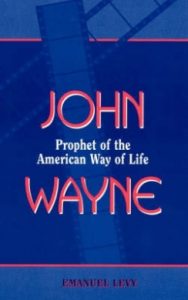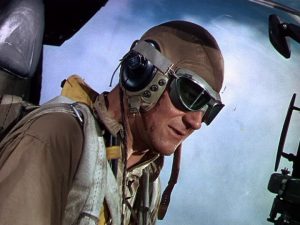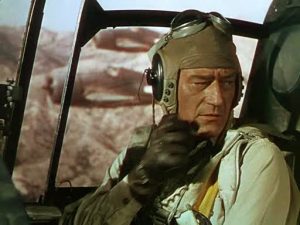The scenario was co-penned by James Edward Grant, one of the two scribes of the 1949 film, who understood well what makes the Duke’s screen persona appealing to the mass public.
John Wayne plays Major Dan Kirby, a commander of the Marine fighting squadron in the South Pacific in 1942, is resented by his men because they wanted executive officer, Captain Carl Griffin (Robert Ryan), a more popular and amiable man, to get the command. They also dislike Kirby for imposing his rugged ways and strict discipline.
The film, however, makes it very clear that, ultimately, it is Kirby who is more suited for command, particularly under pressure. Griffin defends Kirby’s tactics in front of the men, but in privacy he’s critical, telling him, “No man is an island.” When Griffin takes over the command, however, he models his leadership after Kirby. As in other war pictures, in due time, the soldiers learn to respect and even like Kirby for the kind of leader he is.
Note:
If you want to know more about John Wayne’s career and life, please read my book:
Wayne’s toughness turns out to be an exterior façade, and in a sensitive scene, he is seen writing letters of condolence to the families of the casualties.
In another scene, meant to show his softer side, he goes home to visit his wife and gives his son a sword as a souvenir. But he still needs to be asked before telling his wife that he loves her.
The tale touches briefly on the stresses and anxieties of being in command, an issue that dealt with in Wayne’s “Flying Tigers,” and in the Gregory Peck superb 1949 war drama, Twelve O’Çlock High.
“Flying Leathernecks” is helmed by the cult director Nicholas Ray, though producer Howard Hughes did not allow for a personal film, and thus the narrative abounds with generic cliches, such as the allocation of deaths among members of the team, or a pilot, a bronc-buster in civilian life, who loses a leg in action. As a result, it is one of the least distinctive films of Nicholas Ray, who functioned as a gun for hire.
In most of his war movies, Wayne’s roughness is more of a facade. In this picture, Kirby is frustrated when he does not get mail from his family, but he is the one to write letters of condolences to the families of the soldiers who die in combat.
Wayne’s screen leaders are by no means insensitive, especially when it comes to respect for soldiers who have died on duty. In “They Were Expendable,” he states firmly, “a service man is supposed the have a funeral–that’s a tribute to the way he’s spent his life. Escort, firing squad, wrapped in the flag he served under and died for.” Wayne even recites poetry–awkwardly–in honor of one of the casualties who “was always quotin’ verse.”
Narrative Structure (Detailed Synopsis)
The tale follows the classic structure of the arrival of an outsider and the impact of his presence on the group.
Major Dan Kirby (Wayne) arrives at VMF-247 (“Wildcats”) as the new commander when everybody in the unit was expecting Captain Carl “Grif” Griffin (Robert Ryan) to take over.
Assigned to the Cactus Air Force during the Guadalcanal campaign, Kirby, who’s strict and rigid, has few planes available and a lot to accomplish with a field attacked by the Japanese. His pilots are young and behave like “kids,” disobeying orders and losing precious pilots and planes. Captain Griffin, who is not as tough as Kirby, stays closer to his young pilots, one of them is his own brother-in-law Vern “Cowboy” Blithe (Don Taylor).
Kirby knows he is sending pilots to their death, which makes his commitment to missions all the more important, but he keeps this as secret from his squadron. The war’s hard conditions force Kirby to get even stricter with his exhausted pilots. He even refuses sick leave to men with malaria or to allow planes with problems to return to base. Tensions between Griffin and Kirby escalate, though he recognizes the hardships Kirby faces.
Kirby is a fan of low-level ground attacks, but HQ does not approve of his tactics until Marines are dangerously imperiled. Kirby then adjusts squadron tactics, despite losing some pilots while trying to prove his point. He leads his squadron in attack on huge Japanese convoy.
Promoted to Lt. Colonel, Kirby organizes low-level attack tactics in the US, and then returns to the front, to the same unit and aircrew, now equipped with F4U Corsair fighters. Kirby leads his men against Japanese troops and Kamikaze attacks during the Battle of Okinawa. During crucial moment in battle, to avoid splitting his formation, Griffin denies assistance to his brother-in-law Blithe, and as a result Blithe is killed.
Kirby is shot down and injured, but he is picked up by a Navy launch. Forced to leave the squadron, he appoints Griffin CO of VMF-247. They split with friendly promise to meet again. Kirby admits that every moment in which he is required to make a decision is a nightmare, but that is integral to being a leader under tough conditions.
MSgt. Clancy (Jay C. Flippen), an old Marine veteran and friend of Kirby, provides the tale’s comic relief. Clancy uses unorthodox creative methods to obtain provisions for his unit. His improvising helps the poorly equipped VMF-247, but at the end of the film, Clancy loses some stripes.
Howard Hughes, then head of RKO, paid Wayne $301,000, his best pay fee to date.
The picture was a moderate success at the box-office, perhaps a combined function of the market, which saw the release of many war films, as well as the changing mores in American culture post WWII.
Credits:
Directed by Nicholas Ray
Produced by Edmund Grainger
Written by Kenneth Gamet
Screenplay by James Edward Grant and Beirne Lay, Jr.
Music by Roy Webb
Cinematography William E. Snyder
Edited by Sherman Todd
Production and distribution: RKO Radio Pictures
Release date: August 28, 1951 (US)
Running time: 102 minutes
Box office $2.6 million (U.S. rentals)
Cast:
John Wayne as Maj. Daniel Xavier Kirby
Robert Ryan as Capt. Carl “Griff” Griffin
Don Taylor as Lt. Vern “Cowboy” Blithe
Janis Carter as Joan Kirby
Jay C. Flippen as MSgt. Clancy, Line Chief
William Harrigan as Dr. Lt. Cdr. Joe Curran
Brett King as First Lt. Ernie Stark. Brett served in the USAAF earning a DFC and Purple Heart.
Steve Flagg as Capt. Harold Jorgensen
James Bell as Colonel
Barry Kelley as Brigadier General
Maurice Jara as Shorty Vegay
Adam Williams as Lt. Bert Malotke
James Dobson as Lt. Pudge McCabe
Carleton Young as Col. Riley
Michael St. Angel as Capt. Harold Jorgensen, Ops. Officer
Gordon Gebert as Tommy Kirby
Note:
I you want to know more about John Wayne’s life and career, please read my book:
